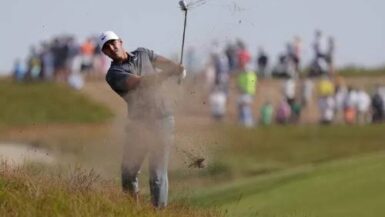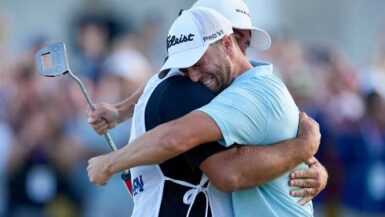LA JOLLA, CA – All I wanted was a frozen coffee and to watch a little golf. Instead, I got crushed, mushed, crammed, jammed, mangled, tangled, beaned, and sardined by what could have passed for the second coming of every tribe of Visigoths that ever invaded Rome, Nome, or the River Somme. That’s what happened when, quite by accident, I walked headfirst into the heaving sea of humanity following the so-called “dream pairing” of Phil Mickelson, Tiger Woods, and their straight-man, Adam Scott, at this year’s U.S. Open.
I went to a golf match and, the next thing I knew, I was in the Torrey Pines version of a pinball machine, hockey game, biker rumble, and the Lower Oakland Roller Derby finals all rolled into one. That’s what I get for liking frappuccinos: one, two, three, blame it all on me.
On day two of the U.S. Open, not only was the crowd raucous, but so was the golf as the top ten players on the leaderboard played sloppily from tee to green, but still ended the day with the lowest scores in five years. As predicted, Torrey has played as mildly as the benign Olympia Yields…I mean Olympia Fields did in 2003. Fairways and greens were for chumps.
Long hitting Stewart Appleby, who has threatened to win a major on a few previous occasions, fired a 1-under 70, despite hitting only eight out of eighteen greens and nine out of fourteen fairways. Appleby’s putter has been sizzling however; he has a mere 51 putts over the two days. His two-day total of 3-under leads Rocco Mediate, Tiger Woods, and Sweden’s Robert Karlsson by one stroke. DJ Trahan, Davis Love III, and Lee Westwood are two back at 1-under. Five more players stand at level par, including former U.S. Open champions Ernie Els (1994, 1997), and Geoff Ogilvy (2006), as well as England’s Luke Donald, Australia’s Robert Allenby and Spain’s Miguel Angel Jimenez..
Appleby wasn’t the only player to turn the normal U.S. Open mantra of “fairways and greens” on its ear. Look at these staggering stats from many of the leaders:
Rocco Mediate – 11 of 18 greens, 11 of 14 fairways, 56 putts (over two days)
Robert Karlsson – 10 of 18 greens, 8 of 14 fairways, 58 putts
Tiger Woods – 14 of 18 greens, 9 of 14 fairways, 59 putts
D.J. Trahan – 9 of 18 greens, 11 of 14 fairways, 55 putts
Davis Love III – 10 of 18 greens, 9 of 14 fairways, 56 putts
Lee Westwood – 8 of 18 greens, 9 of 14 fairways, 56 putts
Robert Allenby – 9 of 18 greens, 7 of 14 fairways, 58 putts
Geoff Ogilvy – 11 of 18 greens, 6 of 14 fairways, 57 putts
These figures are staggering. Since 1951 at Oakland Hills, U.S. Opens have been the toughest test of any golf tournament in the world. “Usually, if you don’t hit it in the fairway, it’s chop it out and play for bogey” remarked former champion Michael Campbell before the tournament began. With 5-over winning scores at Winged Foot and Oakmont, pundits wrote off Angel Cabrera’s remarkable final round 69 – where he hit only five fairways out of fourteen – as a statistical outlier, a stat so out of the ordinary, it should just be discounted as a fluke.
This year, the whole leaderboard is missing fairways and greens, yet scoring like it was an ordinary tour stop. How is it a U.S. Open if driving accuracy and greens in regulation are not rewarded?
“It’s the graduated rough and the first cut around the green” responded the U.S.G.A.’s Vice President of the Executive Committee, Jim Hyler. “The first cut – seven feet wide on either side – is allowing players to show their skill and creativity with recovery shots.”
That’s a welcome departure from prior practice. Shortly after his U.S. Open victory at Winged Foot, champion Geoff Ogilvy lamented that by playing in the U.S., he only got to show off his skill with 60-degree lob wedges. The recovery shot was almost eliminated from the U.S. Open, and the effect was – to use a racing analogy – a restrictor plate on the field, limiting birdies and triggering a long slow attrition. It was almost a test to see who didn’t play the worst instead of who played the best. “We wanted to separate the truly great from the rest, but frequently ended up awarding the trophy to the merely pretty good” quipped Golf Observer writer David Barrett.
Even so, the pendulum may have swung a little too far in favor of being too player-friendly. The U.S. Open’s identity, its raison d’etre, is to be the strictest examination in golf. This year, it’s nearly unanimous, the players say this has been the most fair set-up in many years – and yes, fair means easier. “The Memorial should have been like this” joked Appleby. Excuse me, but when is the Memorial supposed to be tougher than the U.S. Open? Is this year’s U.S. Open just swell-anointed rank and file tour event? Maybe not, but it’s trending that way.
Look at the first and second round scoring averages. At Winged Foot and Oakmont, scoring averages were between 77 and 78 – about seven to eight over par respectively. But at Torrey, the second round scoring average was a meagre 74.88, just 3.88 over par, half as much as in many years of U.S. Opens. The overall scoring average for the first two rounds was 75.25. The scores show this as the easiest open in many decades. It’s clear that for the first two days we have not tested driving accuracy or approach shots enough. The set-up is one major reason.
There are other factors as well. Torrey Pines is Snorey Pines. It has three scoops of plain porridge for greens. The greens at Oakmont, Winged Foot, Shinnecock, Pebble Beach, and Pinehurst have severe internal contouring. Even nearby La Costa Country Club, former home to the Tournament of Champions, has more undulation in the greens than Snorey Pines. ESPN made a big show of how many players were missing short putts, but the stats tell a different storey. Guys are getting up and down from the decks of sinking ships. The greens are fast – 13.5 – but simple.
Next, Torrey lacks vertical and horizontal movement in the land and in the routing- it’s flat and straight. Oakmont, Winged Foot, Shinnecock, and Pinehurst are laid out on terrific terrain for golf. Fairways roll, and sweep and bend over severe hills, deep swales, and play into the teeth of the most ruthless portions of the property. Torrey was routed to show off the views of the ocean and canyons, but not incorporate them. It’s a municipal facility and play must keep moving. Therefore, strategy is kept to a minimum. “If it’s too hard, it’ll take six hours to play” said Craig Harte, a New Yorker who plays Bethpage Black regularly, but played Torrey last year to compare the two. “New Yorkers don’t care – we like showing off how tough we are and how tough our course is. Californians are too laid back for that.”
I guess the old adage is true: live in New York, but leave before it makes you hard, live in Cali, but leave before it makes you soft.
Rees Jones added some ridges to the greens, segmenting them into several smaller targets in one green, but that doesn’t affect the pros like it affects the Justin Timberlakes, Jim Nantz’s and cancer survivors of the world. With U-grooves, superballs for golf balls, cannons for drivers, and harpoon for wedges, the pros are doing things to Snorey that they just couldn’t do to Oakmont. For goodness sake, they play 505-yard par-4s with a driver and a wedge. They are reaching gargantuan par-5s driver, 6-iron. “With the rollback to V-grooves, we’ll at least see them play a game more akin to ours and long iron might be required with greater frequency” said sportswriter Jon Coulotte.
Still, both players and pundits barked, brayed, and bellyached that the tournament was a boring bogey-fest. Patrons pay good, green money to see birdies and they were nearly extinct for decades. To their credit, the U.S.G.A. listened and threw everyone a bone. There’s a bit more balance to the “test.” As they say in Australia, “good onya” to them. With Bethpage up next year, we’ll see the difference between Snorey and the Black. On media day this year, the fairways of the Black were narrower than either side of rough.
This set-up has to favor Woods and today’s round will tell the tale. Based on prior performance, if he’s ahead at the end of the day, he wins and if he’s not, he’ll have to muster his first come from behind win in a major. For goodness sake, his driving distance is a bloated 326.5. Torrey is no Delilah and has no scissors to cut off Samson’s hair. If he makes his putts he wins.
Wind and weather are forecast for the weekend. Moreover, the U.S.G.A. has the course in exactly the shape they want. They can dial in whatever they want. Need the scores a little higher? Tuck the pins and don’t water anything. Is it fine the way it is? Let Mother Nature run the show. It is a testimony to how well Jim Hyman, Chris Wightman, and Mike Davis and all the superintendants have done to get the course in perfect conditio0n for competition – to the micron. Now just make one small adjustment. Make sure the long bombers and sideways hitters don’t escape unscathed.
Oh, and next time, please don’t combine two circuses in one with a 1-2-3 pairing on a golf course with as many bottlenecks as Torrey Pines. As Golf World’s Tim Rosaforte said, “It’s good for TV, but horrible if you’re a paying customer.” After all, everybody needs their seats and frozen coffees to enjoy the day. It’s America, guys. We’re pretty ornery without our coffee.





[…] The Open at Torrey: No fairways? No greens? No problem! […]